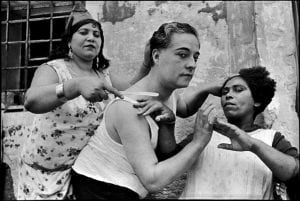Who is the practitioner (what is their name?) and when were they practicing?
The practitioner’s name is Henri Cartier Bresson and, because it is not possible to determine, I’ll say he was practicing between 1908 and 2004.
What is the title of the photo or video you have chosen to analyse (can you provide a link?)
Title: Alicante, Spain, 1933
Where: Spain. Valencia Province. Alicante
When: 1933
URL: https://pro.magnumphotos.com/Asset/-2S5RYDWDPDPD.html

With the photo or video, you are examining when was it produced (date)?
It was produced in Spain, Valencia Province, Alicante in 1933, but it has also been dated to 1932.
How was the photo or video authored?
In 1931, Henri Cartier Bresson bought his first and most treasured camera, a Leica with a 35mm rangefinder lens. With it, the photographer travelled to Europe and visited Spain, Italy and Mexico to take photos of some aspects of everyday life in those countries. For the photo I selected, he went to a brothel in Spain with some friends with the intention of capturing, through a black and white film, the essence of prostitutes and transgender women that work in that place. As André Pieyre de Mandiargues recalls, “what we were seeking . . . was violent emotion, rupture with the disciplines of everyday life as we knew and barely tolerated it” (Galassi, 1987, pp.15).
In the documentary “Henri Cartier-Bresson – The Decisive Moment”, the author of the photograph explains what it is for him to take a picture like the one I’m analyzing right now. He says that his shot is the recognition of an order, is the perfect moment in which every element is connected in relation with the whole scenario. For a portrait, like the one studied, Cartier-Bresson had the intention to show the habitat of the people in frame, showing them grooming each other and getting the sense of vulnerability he wanted everyone to see. His intention was to overthrow the tabues of that time.
How was the photo or video published?
At the time this photograph was taken, publishing a photo wasn’t as simple as digital technology. Its characteristic of being analog meant that the picture had to go under a physical process which included different objects, such as having a dark room, some containers with specific chemicals products on it, and tongs to grab the paper. The website Explain Stuff (Woodford, C 2020) state that the procedure had to be very precise because one mistake could spoil the whole set of negatives .
The Museum of Modern Arts (MoMA) explains how “Alicante, Spain, 1933” was published and provides the details of it. The medium the photographer used was a gelatin silver print and, although it is unknown the real date, it is supposed he developed it between 1933 and 1935 with other photos from the same place. The dimensions vary between museums and art galleries, but the ones from the MoMA are 25.9 × 38.6 cm. The museum remarks that Cartier-Bresson used a european photographic paper that was very easy to handle in the darkroom, because, as they recall, the artist didn’t like the process at all.
How was the photo or video distributed?
Alicante, Spain, 1933 was part of the first exhibition that Henri Cartier Bresson participated in. It was in 1933, at the Julien Levy Gallery in New York, when he showed publicly the photos he had taken in Europe to the people that participated in the event, the first time they were distributed to multiple viewers. In the same year, he made his second exhibition, but now in the country where he took the photo: Spain. However, his book The Decisive Moment was the one that made him recognisable to most people. In it, the photographer collected his best pieces with the intention of demonstrating how pictures capture an instant of life and how the artist has to try to evoque that.

In 1947, Henri and other photographers founded Magnum Photos, which was a cooperative picture agency that was created to designate work between them, in order to capture the best of almost every continent. Nowadays, you can find their pieces, as the one analyzed, on the Magnum Photos website, making it accessible to everyone that can enter the internet. Physical and online museums also have Cartier-Bresson photos available, reflecting new ways in which his art is being distributed now he has passed.
References
– André Pieyre de Mandiargues, quoted in Peter Galassi, Henri Cartier-Bresson: The Early Work (New York: The Museum of Modern Art, 1987), p. 15.
– Ateneo de Madrid n.d., ‘1933. Henri Cartier-Bresson expone en el Ateneo de Madrid’, Ateneo de Madrid, viewed 5 April 2020, <https://www.ateneodemadrid.com/Archivo/Documentos/Documentos-destacados/1933.-Henri-Cartier-Bresson-expone-en-el-Ateneo-de-Madrid>
– Daffner, L, Morris, M n.d., ‘Object Photo’, Museum of Modern Arts, viewed 4 April 2020, <https://www.moma.org/interactives/objectphoto/objects/83982.html>
– Fondation Henri Cartier-Bresson n.d., ‘Biography’, Fondation Henri Cartier-Bresson, viewed 4 April 2020, <https://www.henricartierbresson.org/en/hcb/biography/>
– Museum of Modern Art 2020, ‘Henri Cartier-Bresson Alicante, Spain 1932’, Museum of Modern Arts, viewed 4 April 2020, <https://www.moma.org/collection/works/49438>
– O’Hagan, S 2014 ‘Cartier-Bresson’s classic is back – but his Decisive Moment has passed’, The Guardian, 24 December, viewed 5 April 2020, <https://www.theguardian.com/artanddesign/2014/dec/23/henri-cartier-bresson-the-decisive-moment-reissued-photography>
– The Decisive Moment 1973, streaming video, Cornell Capa, United States of America, viewed on April 4 2020, <https://vimeo.com/178360907>
– Woodford, C 2020, Film Cameras and 35mm Photography, Explain That Stuff, viewed 4 April 2020,<https://www.explainthatstuff.com/how-film-cameras-work.html>